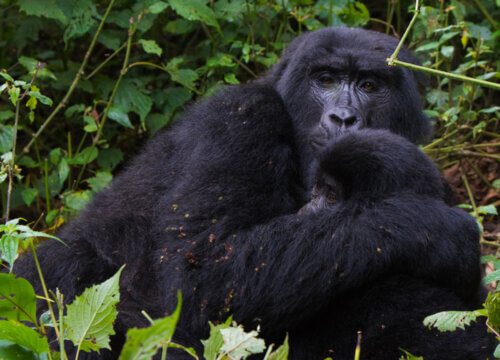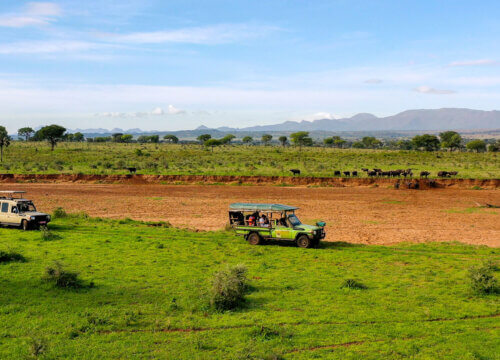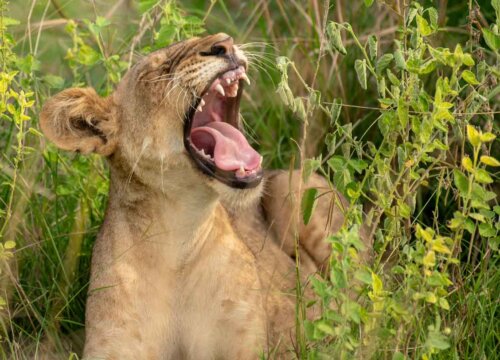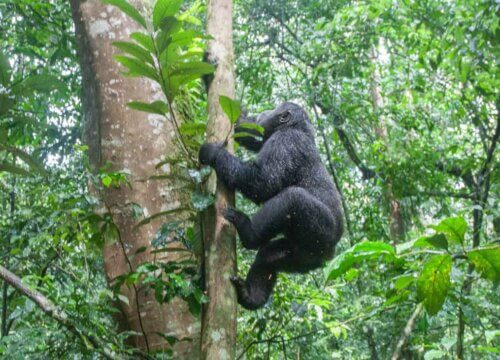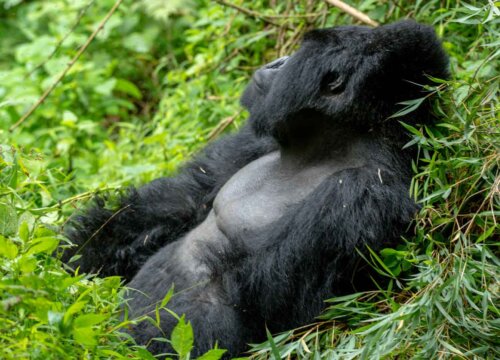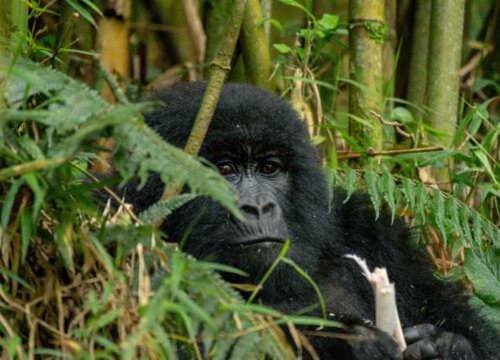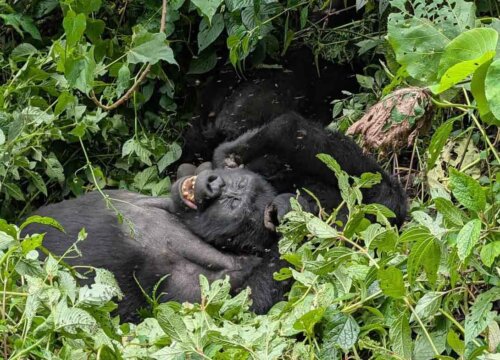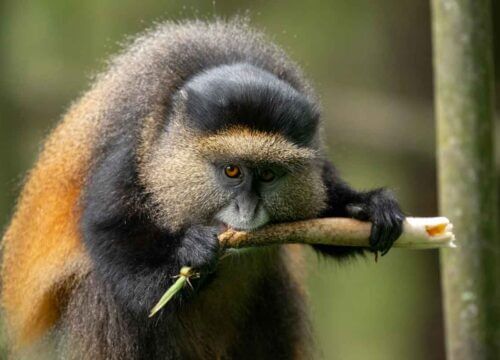What happens in case I do not see gorillas on the day of trekking in Uganda
What happens in case I do not see gorillas on the day of trekking in Uganda
Gorilla trekking in Uganda is an incredible adventure offering a rare opportunity for visitors to see these gorillas in their natural environment. You have 99% chances of meeting gorillas on your trek but if this happens, do not be discouraged. Uganda Wildlife Authority offers alternative options such as a chance to reattempt the trek on a different day in Bwindi Impenetrable Forest and Mgahinga Gorilla National Park. Gorilla trekking is possible during every season so be sure to see gorillas even in heavy rains. Remember that the guides work tirelessly to maximize your chances of gorilla spotting.
Gorilla trekking is one of the activities that you should not miss on your list as you plan to visit Uganda because it is a very organized activity that is possibly done all year round. In our article, we are going to take a look at the chances of seeing gorillas, what you need for gorilla trekking and where to do it.
Where to do gorilla trekking in Uganda
Gorilla trekking is mainly done from two destinations that is Bwindi Impenetrable Forest and Mgahinga Gorilla National Park which offers attractive trails such as the hike to Mount Sabinyo where trekkers can stand at the intersection of Uganda, Rwanda and the Democratic Republic of Congo.
Bwindi Impenetrable National Park is one of the most treasured natural reserves in Southwestern Uganda with four sections where Gorilla trekking takes place that is Nkuringo sector, Ruhija sector, Rushaga sector and Buhoma sector. They are open for gorilla trekking all year around.
Bwindi Impenetrable Forest National Park has a dense rainforest, steep hills and deep valleys which makes it globally recognized as a sanctuary with more than 1064 mountain gorillas and 24 habituated gorilla families. Apart from its famous primates, Bwindi is home to more than 120 mammal species, 350 bird species, 51 reptiles and other primate species like baboons, red tailed monkeys, black and white colobus monkeys, L’hoest monkeys and many others. Note that this is the only national park where gorilla habituation takes place.
Mgahinga Gorilla National Park is located in southwestern Uganda and is part of the larger Virunga conservation area which extends to Uganda, Rwanda and Democratic Republic of Congo. It is also home to golden monkeys, more than 180 bird species and three majestic volcanoes that is Mount Gahinga, Mount Sabyinyo and Mount Muhabura. Mgahinga Gorilla National Park is the smallest national park in Uganda having one habituated gorilla family called Nyakagezi gorilla family. This family used to migrate to Rwanda and DRC but is now permanently living in Mgahinga and is tracked by a maximum of 8 people each day.
Visitors can enjoy gorilla trekking, golden monkey tracking, birdwatching and hiking adventures from this park. The Batwa cultural experience is another highlight that offers insight into the traditions of the Batwa people who are the original residents of Mgahinga Gorilla National Park.
Gorilla trekking experience in Uganda
Going on a gorilla trekking experience is very magical. Imagine walking through green forests, smelling air filled with the sounds of nature as you make your way towards this rare gorilla meeting.
The journey begins at the park headquarters with briefing about the rules and regulations regarding gorilla trekking. This is the time when tourists are divided into groups of 8 to track each available gorilla family. After grouping, you are led by a knowledgeable guide through the dense vegetation while sharing insights about the ecosystem and the gorillas you are about to meet. Gorilla trekking takes 30 minutes to 6 hours depending on your physical fitness and the location of the gorilla family you are tracking. When you finally spot a gorilla family, you are given an hour to watch juvenile gorillas playing around, mothers caring for their young ones and silverbacks watching over their group. You can use this chance to take photos and videos with no flashlight to disturb gorillas. You are then escorted back to your starting point where you will be rewarded with gorilla trekking permits for participation. Gorilla trekking is another crucial way to support conservation efforts as permits and tourism help fund the protection of gorillas. So, if you are looking for an adventure that is both exciting and meaningful, gorilla trekking is an unforgettable journey worth participating in.
For more information about Gorilla trekking, please contact Giant Holiday Safaris.
How to book a gorilla trekking trour
The first step of seeing gorillas in Uganda is by purchasing a gorilla trekking permit. It is advisable to book your permit at least 6 months before the trek date. This is a legal document issued by Uganda Wildlife Authority and it is given to trekkers of legal age that is 12 years and above. The easiest way of purchasing permits is through Uganda Wildlife Authority or Giant Holiday Safaris, a trusted tour company. You just need to get in touch with our tour operator with your name, passport, number of permits you want to buy and your gorilla trekking dates. Our tour operator will then check for the availability of the permits and get back to you. In case permits are available, you are requested to make payment for your gorilla permit purchase. After receiving your payment, our tour operator purchases permits on your behalf and will send you a copy for record purposes.
Gorilla trekking tour cost in Uganda
The gorilla trekking cost is set by Uganda Wildlife Authority and the price of your trip is influenced by season of travel, accommodation, transport, size of the travel group as follows;
Gorilla trekking permits cost 800 USD per person per trek for foreign non-residents, 700 USD per person per trek for foreign residents, 300,000 UGX per person per trek for East African citizens and 500 USD per person per trek for African citizens.
For visitors interested in gorilla habituation, East African citizens pay 750,000 UGX per permit, 1500 USD per person per trek for foreign non residents and 1000 USD per person per trek for foreign residents
Season of travel. Travelling can be done in two seasons that is the peak or dry season from June to September and the low or rainy season from March to May and late October to November. The season chosen determines the cost of your trip. Note that travelling during the dry or peak season is more expensive than travelling in the rainy season because the tourists are always many and permits are on high demand.
Accommodation. You can choose your lodge depending on your budget. Accommodation in Bwindi Impenetrable Forest National Park and Mgahinga Gorilla National Park is divided into 3 categories that is budget, mid – range and luxury.
For more details about the best accommodation to fit your budget, please contact Giant Holiday Safaris
Transport. Bwindi Impenetrable Forest National Park and Mgahinga Gorilla National Park can be accessed by road or air transport. Air transport is the most convenient means of transport though it is very expensive and will increase your tour budget. On the other hand, road transport is the most common means of transport used and it gives you beautiful views of the park.
Size of travel group. Travelling alone is expensive compared to travelling in large groups because accommodation and transport can be shared within the group.
More activities to consider. You can combine gorilla trekking with activities like guided nature walks, birding, game drives, cultural trips, butterfly watching and many others. In case you choose more activities, your trip cost will also increase.
Gorilla trekking rules in Uganda
Gorilla trekking in Uganda is a rare experience that allows visitors to see mountain gorillas in their natural environment. However, this activity comes with specific rules and guidelines set by Uganda Wildlife Authority to ensure the safety of both the gorillas and their environment and trekkers. Below are the key rules to follow during a gorilla trekking trip in Uganda.
- A gorilla trekking permit is mandatory and must be acquired through the Uganda Wildlife Authority or licensed tour operators. The permits are limited to a specific number of visitors per day to minimize human impact on the gorillas and their environment.
- Only individuals aged 12 years and above are allowed to participate in gorilla trekking. This rule ensures that participants have the physical capability to handle the trek and reduces risks associated with younger children’s unpredictable behavior.
- Trekkers are required to maintain a minimum distance of 7 meters from the gorillas at all times. This helps to prevent the transmission of diseases from humans to gorillas.
- Avoiding trekking if you are ill. Coughing, sneezing or any other signs of illness should be reported to guides immediately.
- Once a gorilla family is located, visitors are allowed to spend only one hour observing them. This minimizes stress on the animals and ensures their natural behaviors are not disrupted.
- Avoid loud noises because they disturb gorillas and other wildlife which potentially leads to aggressive behavior or flight responses.
- It is crucial to follow professional guides and ranger’s instructions at all times including maintaining group unity and avoiding sudden movements.
- Touching or feeding gorillas is strictly forbidden. Any physical contact can pose health risks to both parties and disrupt their natural behaviors.
- Photography is allowed but should be done without flash because it can frighten or anger gorillas.
What to pack for a gorilla trip in Uganda
Planning a gorilla trekking adventure in Uganda should be done with packing the right gear as guided below;
- Pack lightweight and moisture-wicking clothes that will keep you comfortable during long hikes. Long-sleeved shirts and long pants are also highly recommended to protect you from scratches, insects and the sun.
- A good pair of waterproof hiking boots is a must because trails can be muddy and slippery especially during the rainy season. Do not forget try on your boots before the trip to avoid blisters.
- Pack a waterproof jacket to stay dry in case of rain during your trek.
- Thick gardening or trekking gloves are a useful item to protect your hands from thorny plants and provide extra grip when climbing or holding onto branches.
- A small comfortable backpack is important for carrying your essentials during the trek. Look for one with space for a water bottle as staying hydrated is crucial.
- Bring a good insect repellent to protect yourself from insect bites and mosquitoes.
- Pack sunscreen and a wide-brimmed hat to shield yourself from harmful UV rays.
- Bring a camera with a good zoom lens to photograph gorillas from a safe distance. Binoculars will also improve your experience by helping you spot wildlife in the treetops.
- Pack some energy boosting snacks like nuts or granola bars. Do not forget to carry enough water to stay hydrated throughout the hike.
- Last but not least, ensure you have your passport, gorilla trekking permit and any other necessary travel documents safely packed.
Where to stay in Uganda during your gorilla trekking trip
Accommodation in In Bwindi Impenetrable National Park and Mgahinga Gorilla National Park range from luxury, mid-range to budget. Make sure you choose a lodge that is near your trekking destination. Below are some options;
In Bwindi Impenetrable National Park. Consider choosing from Icumbi Gorilla Lodge, Nshongi camp, Rushaga Gorilla Havens Lodge,Lake Mutanda Resort, Gorilla valley lodge, Buhoma Lodge, Clouds Mountain Gorilla Lodge ,Broadbill tented camp, Ruhija gorilla safari lodge and many others.
In Mgahinga Gorilla National Park. This park has lodges like Lake chahafi lodge, Lake Mulehe lodge, Gahinga lodge and others.
In case you want more information about lodges that better suit your budget, contact Giant Holiday Safaris.
What is the best time for gorilla trekking in Uganda?
Gorilla trekking is possible throughout the year. However, Uganda has two main dry seasons which are considered the best times for trekking. These are from December to February and June to September. During these months, the trails in Bwindi Impenetrable National Park and Mgahinga Gorilla National Park are less muddy and easier to cross which makes gorilla trekking more enjoyable. Vegetation is also thinned out making gorilla spotting easy.
While gorilla trekking is possible year- round, the rainy seasons that is from March to May and October to November can make the trails slippery and more challenging though some travelers still choose these months as permits may be easier to secure and the parks are less crowded which makes gorilla trekking peaceful and private.
Lastly, note that it is not possible for visitors to visit Uganda with an aim of gorilla trekking and miss out spotting them because the Ugandan government has made it the most organized activity.
Get in touch with the team at Giant Holiday Safaris for a smooth and planned gorilla trekking experience in Uganda and neighboring countries.
Explorer More Safaris
- 14-Days Uganda Safari Gorilla Chimpanzees and Wildlife
- 12 Days Gorillas and Chimpanzees Wildlife Safari
- 10 days best of uganda primates & wildlife safari
- 6 Days Gorillas and Chimpanzee Trekking Safari
- 3 Day Bwindi Gorilla Trekking Safari
- 4 Day Uganda Gorilla Trekking and Wildlife Safari
- 4 Days Gorilla Trekking and Adventure Safari
- 5 Days Uganda Gorillas and Chimpanzee Tracking Safari
- 4-Day Rwanda Gorilla Trekking and Golden Monkey Tracking Safari
- 5 Day Gorilla Habituation and Chimp Trekking
- 4-Day Uganda & Rwanda Gorilla Trekking Tour
- 3 Days Bwindi Gorilla Trekking Ugnada from Rwanda
- 10 Days Uganda Primates and Game Safari

